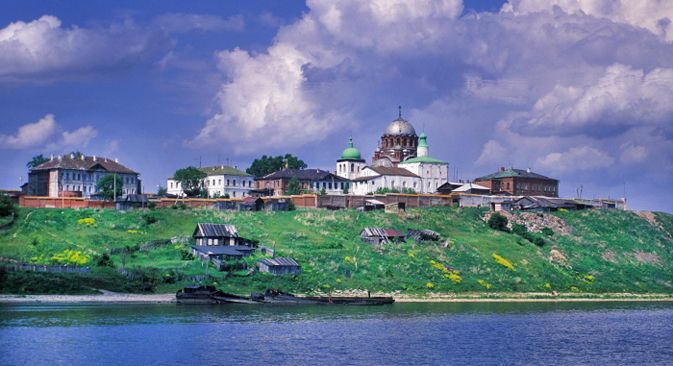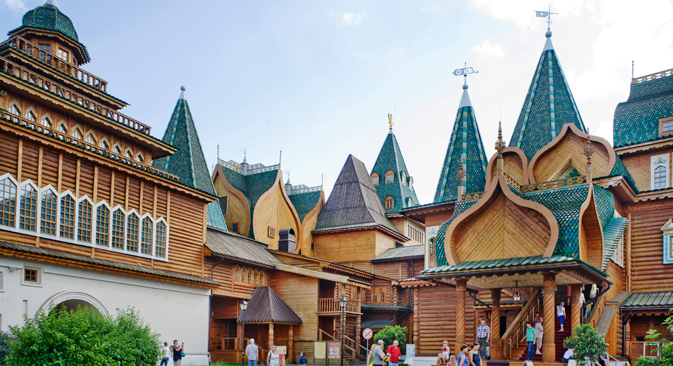Sviyazhsk: Ivan the Terrible’s fortress on the Volga

Photographs by William Brumfield
Today the small settlement of Sviyazhsk rests serenely on a hill on an island in the Volga River, just upriver from Kazan. The crown of the hill is graced with churches and monastery walls that convey the appearance of a medieval kingdom. Yet despite this peaceful view, Sviyazhsk was from the moment of its founding at the center of one of the most dramatic, violent episodes in Russian history: the taking of the fortress city of Kazan by Ivan the Terrible in 1552.
The Tatar Khanate of Kazan was established in 1438 from the increasingly fragmented Golden Horde. Relations with Muscovy were constantly changing as part of a complex pattern that involved not only Kazan, but also the Crimean Khanate (established as an Ottoman vassal state in 1478), the Nogai Horde and various smaller entities such as the Kasimov Tatars, who accepted Moscow’s authority in the 1450s.
Kazan, however, remained the primary challenge to Moscow in view of its strategic location on the Volga River near its confluence with the Kama, the major river in the western Ural Mountains. A number of clashes occurred during the first half of the 16th century, but without conclusive results. As long as Kazan existed as a threat, Russian movement into and beyond the Urals, as well as south toward the Caspian Sea, was blocked.
Unsuccessful campaigns launched by Ivan in 1547 and 1549 from Nizhny Novgorod, which is located on the Volga at the mouth of the Oka River, made it clear that a forward base on the Volga was required in order to support and supply such a complicated operation. Yet creating the base itself required a location that was both accessible and defensible. The chosen site was a promontory that overlooked the Sviyaga River at its merger with the Volga some 15 miles north of Kazan.
Ivan’s massive offensive required the rapid construction of a fortress, and to that purpose thousands of logs were cut and shaped during the winter of 1550-51 near Uglich, on the upper Volga. With careful organization, the logs would be floated down the Volga and assembled as an innovative pre-fabricated fortification.
In late May 1551, Muscovite forces disembarked at the site of the future Sviyazhsk on land that traditionally belonged to the Chuvash people. The titular head of the force was the Kasimov Khan Shahgali, a calculated gesture that symbolized allegiance to Moscow among a significant group of Tatars.
Trees on the hill were quickly felled in preparation for the floating fortress. With deft coordination, the rafts of logs were captured and assembled within four weeks into a large fort whose territory exceeded that of the Moscow Kremlin. Astounded by the rapidity of the fort’s construction, large segments of the local population swore their allegiance to Moscow.
How to get there
To get to Sviyazhsk first take a regular train or flight from Moscow to Kazan, than you need take a boat to Sviyazsk (departure 8.20 am every day). The trip takes approximately 2 hours.
During the same period, Cossacks and cavalry led by Prince Peter Serebryanny-Obolensky launched destructive raids around Kazan, thus isolating the city from relief forces, particularly from Crimea. As summer progressed, it appeared that Kazan had accepted Moscow’s authority, and by August 1551 Shahgali, who was loyal to Moscow, had been proclaimed khan of Kazan.
Much local dissatisfaction remained, however, and Shahgali’s attempts to suppress it only led to further resentment. Uncertain of his power, Khan Shahgali left Kazan in early March 1552 and brought much of his force to the Sviyazhsk fortress. Moscow’s attempts to reassert control in Kazan were unsuccessful, and the walled city stood ready for battle under the leadership of Khan Yadegar Mokhammad.
During the renewed Muscovite campaign against Kazan, which began in early July 1552 and lasted until the city was taken by storm on Oct. 2, Sviyazhsk played a critical role in supporting Ivan IV’s large army and its artillery. The strategic calculations that led to its founding were amply justified.
After the conquest of Kazan, Sviyazhsk lost its strategic purpose and became a local administrative center. Much of the hilltop was given to monasteries founded after the construction of the fortress in 1551. The first of these, with a dual dedication to the Trinity and to St. Sergius of Radonezh, lasted from 1551 until 1764, when Catherine the Great the ordered the closing of many small monasteries as part of a reorganization of the monastic system in Russia.
The most renowned of the Sviyazhsk monasteries was dedicated to the Dormition of the Virgin. Five years after the monastery's founding in 1551, work began on the masonry Dormition Cathedral. Consecrated in 1560, the cathedral is a curious amalgam of architectural elements from medieval Pskov and decorative flourishes added in the 17th and 18th centuries. Indeed, some have attributed the main design to the same Postnik Yakovlev of Pskov who is also considered one of the authors of the Intercession Cathedral on Red Square, popularly known as St. Basil’s.
The interior of the Dormition Cathedral is equally notable for its 16th-century frescoes, many of which have survived and were restored in the 1990s. Of particular interest is the fresco cycle devoted to the expulsion of Adam and Eve from paradise. Painstaking restoration work continues on the cathedral as well as on the Church of St. Nicholas (1550s), which is built around a massive bell tower. The walled monastery also contains a rebuilt refectory church (1799) dedicated to prelates Herman of Kazan and Mitrofan of Voronezh in addition to an early 18th century Ascension Church over the Holy Gates.
The third monastic institution at Sviyazhsk, the Convent of John the Baptist, has had a complicated history. Founded in the late 16th century by Ivan the Terrible, the convent was plagued by fires in the 1750s. Rather than rebuild, the convent was relocated to the territory of the former Trinity-St. Sergius Monastery, whose ancient buildings it appropriated.
The earliest structure — and the earliest surviving Orthodox church in Tatarstan — is the small, wooden Church of the Holy Trinity, built in 1551 during the construction of the Sviyazhsk fortress. Remarkably, its stout larch logs have stood the test of time, although the crown was modified in the 19th century.
The other ancient church inherited by the convent is the Refectory Church of St. Sergius, apparently constructed as early as the 1570s, although written sources date its consecration to 1604. Built of limestone blocks by Pskov masons, the church has retained its dedication in homage to the predecessor monastery. The image of St. Sergius — the avatar of 14th-century Muscovite monasticism — is preserved in a large wall fresco of the Old Testament Trinity in the church vestibule.
The largest church in the convent is the Cathedral of the Icon of the Virgin, “Joy of All who Grieve.” Erected in 1898-1906 from a design in the neo-Byzantine style by the Kazan architect Fedor Malinovsky, the imposing red brick structure is the dominant landmark in views of Sviyazhsk from the Volga. Fortunately, much of its wall painting survived the Soviet era, and the cathedral has now undergone a major restoration.
Damage to the architectural heritage of Sviyazhsk during the Soviet period was severe and included the demolition of the Nativity Cathedral, built in 1567 in the center of the fortress town. Other churches and monastic structures were destroyed or vandalized, and monastery enclosures were converted to forced-labor camps.
Another major challenge to the existence of Sviyazhsk resulted from the vast post-war hydroelectric projects that transformed part of Volga River into an inland sea, the Kuibyshev Reservoir. With rising water levels, the Sviyazhsk promontory had become an island by 1957. Land access was restored only a half century later with the completion in 2008 of a dam and roadway connecting Sviyazhsk to the left bank of the Sviyaga River via the Tatarskaya Griva Island.
Renewed land transportation has improved the economic situation of Sviyazhsk, whose current year-round population is approximately 250. However, most visitors to the island will prefer a picturesque Volga River journey from Kazan or Zelenodolsk. The opening in 2011 of a new river station, with an information center and café, has significantly enhanced the experience of travel to Sviyazhsk. As restoration of its historic monuments continues, Sviyazsk offers a view into Russia’s past, as well as a remarkably beautiful natural setting.
All rights reserved by Rossiyskaya Gazeta.
Subscribe
to our newsletter!
Get the week's best stories straight to your inbox

